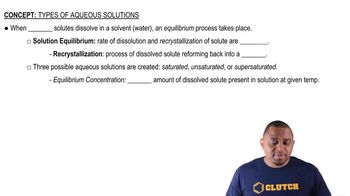Here are the essential concepts you must grasp in order to answer the question correctly.
Supersaturated Solutions
A supersaturated solution contains more solute than can typically dissolve at a given temperature. This state is achieved by dissolving the solute in hot solvent and then cooling it slowly. The solution is unstable, as it holds excess solute that can precipitate out, leading to crystallization when disturbed or over time.
Recommended video:
Types of Aqueous Solutions
Equilibrium in Solutions
A solution is in equilibrium when the rate of solute dissolving equals the rate of solute crystallizing. In a saturated solution, this balance is maintained. However, when excess solute crystallizes out of a supersaturated solution, the system can shift towards a new equilibrium, indicating that the previous state was unstable.
Recommended video:
Stability of Chemical Systems
The stability of a chemical system refers to its ability to maintain a state of equilibrium without external influence. In the case of a supersaturated solution, once excess solute crystallizes, the system is no longer in its previous unstable state and must adjust to reach a new equilibrium, which may be more stable.
Recommended video:
Intepreting the Band of Stability





